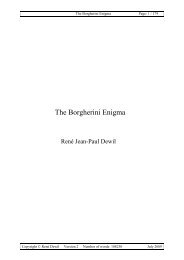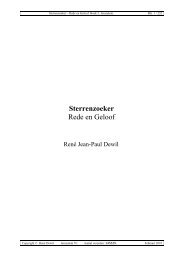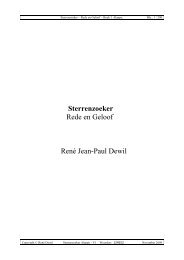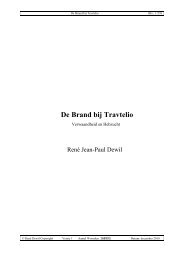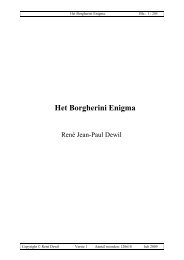A visual Journey into the Bible The Book of Genesis
A visual Journey into the Bible The Book of Genesis
A visual Journey into the Bible The Book of Genesis
You also want an ePaper? Increase the reach of your titles
YUMPU automatically turns print PDFs into web optimized ePapers that Google loves.
A Visual <strong>Journey</strong> <strong>into</strong> <strong>the</strong> <strong>Bible</strong> Page: 26<br />
<strong>of</strong> Trent and pictures <strong>of</strong> Adam and Eve nude were not unusual. After all, <strong>the</strong> <strong>Bible</strong><br />
noted explicitly that Adam and Eve were naked and not ashamed. That was before <strong>the</strong><br />
Fall, as in Cranach’s picture. <strong>The</strong> clergy could hardly protest against a scene that had<br />
a sound <strong>the</strong>ological basis. Puritanism set in later. <strong>The</strong> Fall had a special meaning for<br />
Lu<strong>the</strong>r and <strong>the</strong> Protestants. It underscored <strong>the</strong> frailness <strong>of</strong> humanity and original sin<br />
and illustrated some <strong>of</strong> <strong>the</strong> pessimism <strong>of</strong> <strong>the</strong> Protestants. <strong>The</strong> Renaissance had<br />
glorified man, built imposing monuments on majestic antique non-Christian<br />
examples. <strong>The</strong> Roman Catholic Church all too eagerly liked pomp and outward<br />
magnificence to show <strong>the</strong> power <strong>of</strong> its clergy more than <strong>the</strong> modesty <strong>of</strong> Christ. <strong>The</strong><br />
Protestants would remark that man had to pray and be humble again. If <strong>the</strong><br />
Renaissance tried to reach <strong>the</strong> skies, <strong>the</strong> German Protestants pointed at <strong>the</strong> reality <strong>of</strong> a<br />
hard life that was <strong>of</strong>ten miserable in feudal Germany. Cranach made several versions<br />
<strong>of</strong> <strong>the</strong> Fall, which became one <strong>of</strong> <strong>the</strong> preferred <strong>the</strong>mes <strong>of</strong> <strong>the</strong> German Protestants.<br />
Adam and Eve<br />
Vladimir Baran<strong>of</strong>f-Rossiné (1888 – 1942). Museo Thyssen-Bornemisza – Madrid.<br />
1912.<br />
<strong>The</strong> <strong>the</strong>me <strong>of</strong> Adam and Eve, representations <strong>of</strong> <strong>the</strong> first men but also types <strong>of</strong> all<br />
mankind, inspired artists <strong>of</strong> later than <strong>the</strong> early centuries <strong>of</strong> oil painting and o<strong>the</strong>r<br />
artists than <strong>of</strong> Western Europe. Vladimir Baran<strong>of</strong>f-Rossiné was born in <strong>the</strong> Ukraine,<br />
in <strong>the</strong> town <strong>of</strong> Kherson. He studied painting in Odessa and in Saint Petersburg. He<br />
moved in <strong>the</strong> group <strong>of</strong> Russian avant-garde artists where he met Larionov and Natalia<br />
Gontcharova among o<strong>the</strong>rs. In 1910 Baran<strong>of</strong>f-Rossiné left Russia for Paris and tied<br />
friendships with <strong>the</strong> Parisian society <strong>of</strong> Russian émigrés but also with Hans Arp and<br />
Robert and Sonia Delaunay. From this period dates his ‘Adam and Eve’ in which <strong>the</strong><br />
influence <strong>of</strong> <strong>the</strong> aforementioned artists can be felt in <strong>the</strong> strong, heavy colours and <strong>the</strong><br />
encircling dynamism. Baran<strong>of</strong>f-Rossiné also sculpted and tended to a unity in <strong>the</strong><br />
various arts <strong>of</strong> painting, sculpture, poetry and music. He combined <strong>the</strong>se arts in stage<br />
performances. During <strong>the</strong> First World War he hid in Norway. He returned to Russia,<br />
now a communist nation in <strong>the</strong> growing, already in 1917. He met Marc Chagall and<br />
o<strong>the</strong>r Russian innovators <strong>of</strong> painting. In his later years Baran<strong>of</strong>f-Rossiné came back to<br />
Paris and he died <strong>the</strong>re in 1942, in <strong>the</strong> middle <strong>of</strong> a new World War. Until his death he<br />
continued to experiment with colours.<br />
Vladimir Baran<strong>of</strong>f-Rossiné’s ‘Adam and Eve’ is all colours. His painting strikes with<br />
its embedded, concentric circles between which colours and subjects are trapped. <strong>The</strong><br />
obsession <strong>of</strong> whirling circular movements that engulfed all subject matter was a<br />
characteristic <strong>of</strong> a style <strong>of</strong> painting <strong>of</strong> <strong>the</strong> beginning <strong>of</strong> <strong>the</strong> twentieth century called<br />
Orphism. <strong>The</strong> main artists who left <strong>the</strong> representation <strong>of</strong> figurative subjects for <strong>the</strong>se<br />
circling colours were Frantisek Kupka and Robert and Sonia Delaunay, who all<br />
worked in Paris. Baran<strong>of</strong>f-Rossiné’s ‘Adam and Eve’ can thus also be called an<br />
Orphist picture, even though <strong>the</strong> Orphists tended to complete abstraction whereas<br />
Baran<strong>of</strong>f-Rossiné remains mainly figurative in his painting.<br />
For Baran<strong>of</strong>f-Rossiné <strong>the</strong> sun is <strong>the</strong> creator <strong>of</strong> life. It’s warm and red light is central. It<br />
does not send out rays but life is created in concentric circles. All life is generated<br />
Copyright ©: René Dewil Date: October, 24 2000



